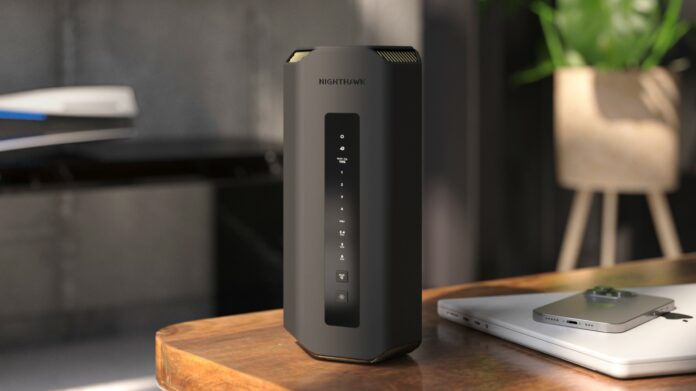With Wi-Fi 6 still drawing blood at the cutting edge of wireless networking technology, Netgear and its competitors are already taking stabs at what even-more-advanced Wi-Fi 7-capable routers will look like.
The new Netgear RS700, launched Tuesday, is an indication that the Wi-Fi 7 future could be full of routers with commanding physical presence (in addition to what we hope are more reliable signals). The RS700, which will retail for an eye-watering $700 when it goes on sale this spring, is among a new class of consumer routers that ditches the traditional black rectangle with pointy antennas in favor of a taller enclosure with integrated antennas that resembles a desktop PC tower.
The new form factor, which TP-Link is also using for some of its Wi-Fi 7 routers, is intended to improve antenna performance. By placing the antennas inside the enclosed tower, the RS700 will suffer from less interference caused by the cables that connect the antennas to the rest of the Wi-Fi circuitry, Netgear claims. Coupled with redesigned RF circuits, the RS700’s new antennas can push Wi-Fi 7 signals further than they’ve gone before from existing Nighthawk routers, according to the company.
The increased range may not matter as much for early adopters, however, since one of Wi-Fi 7’s chief benefits is the ability to transmit on the relatively uncrowded 6GHz radio spectrum. The FCC still hasn’t licensed routers to transmit at full power on the 6GHz band the way they can on the 2.4GHz and 5GHz bands, so your data-hungry devices may not benefit from the advantages of the RS700’s increased signal strength immediately.
Still, life at the bleeding edge is all about being prepared for what comes next. Netgear points out that once full-power 6GHz transmissions are possible, the new Nighthawk’s capabilities will be fully unleashed via a firmware update. Other future enhancements include the ability to join multiple RS700 routers together to form a mesh network, and the addition of seperate SSIDs for high-priority devices (like gaming consoles) and lower-priority ones such as door bells and thermostats.
It’s a Wide, Wide, Wi-Fi 7 World
While a subset of Wi-Fi 6 devices (known as Wi-Fi 6E) can already operate on the 6GHz band, Wi-Fi 7 will refine this capability further. The RS700 will be more flexible with how it handles interference on a channel within the 6GHz band. Instead of switching to a new channel (or disconnecting entirely) if there’s interference, the new Nighthawk will take advantage of Wi-Fi 7’s ability to steer data packets around the interference and send them on their way.
(Credit: Netgear)
Capabilities like these don’t actually make the channels physically wider, but they do mean that Wi-Fi 7 will be able to use more of the spectrum available to it more of the time. Check out our explainer for more on how the new wireless protocol works.
Recommended by Our Editors
Of course, one of the main reasons why you’d want a cutting-edge router is to ensure you can access the full bandwidth of the internet plan you’re paying your ISP for. So in addition to Wi-Fi 7 support, the Nighthawk RS700 also comes with some astonishing wired speeds to support a new generation of “gigabit-plus” plans. Its 10-gigabit WAN port can be used on its own with supported modems, or can be linked with another gigabit port to form “internet aggregation,” with two ethernet cables joining the router to the modem.
In addition to the RS700 and TP-Link’s Wi-Fi 7 offerings, Asus has also tipped two Wi-Fi 7-capable routers, the RT-BE96U and the ROG Rapture GT-BE98.
 Readers’ Choice 2022: Wireless Routers & Network Attached Storage Devices
Readers’ Choice 2022: Wireless Routers & Network Attached Storage Devices
Get Our Best Stories!
Sign up for What’s New Now to get our top stories delivered to your inbox every morning.
This newsletter may contain advertising, deals, or affiliate links. Subscribing to a newsletter indicates your consent to our Terms of Use and Privacy Policy. You may unsubscribe from the newsletters at any time.
Hits: 0

















